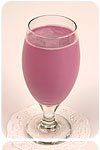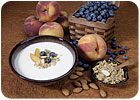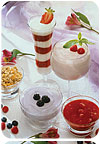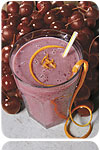
Classic healthful dairy foods such as yogurt represent an obvious launching point for fiber fortification. However, new and innovative approaches to making indulgent dairy products healthier represents an excellent potential for expanding market segments to consumers who would normally limit or avoid these products.
Photo courtesy of Roquette America Inc.
Photo courtesy of Roquette America Inc.
Here's Who Dairy Foods Talked To
Donna Brooks,product manager, Danisco SweetenersAllan Buck,director of research and development, ADM Food Ingredients
Deborah Dihel,business development manager, National Starch Food Innovation
Melanie Dineen,applications technologist, SunOpta Ingredients Group
Ben Moser,associate program coordinator technology/applications development, Roquette America Inc.
Jenny Norton,food scientist, TIC Gums
Joseph O'Neill,executive vice president sales and marketing, Orafti North America
Declan Roche,director of new technology platforms, Kerry Ingredients-Kerry Specialty Ingredients
Pam Stauffer,marketing programs manager, Cargill Health & Food Technologies, Cargill Inc.
Juliana Zeiher,ingredients technologies manager, GTC Nutrition

Fiber-fortified smoothies make lots of sense since smoothies are considered a healthful beverage.
Photo courtesy of Cargill Inc.
Photo courtesy of Cargill Inc.
Dietary fiber might only be found in plants; however, that fiber can be processed into ingredients and delivered to the consumer via dairy foods.Dairy Foodsspoke with 10 suppliers of food-grade fiber ingredients to get their opinion on the opportunities dairy processors have with using their wares as the vehicle to deliver dietary fiber to Americans. Here's what the experts had to say.

Fiber fortification is one way that the dairy industry can add additional nutrients to a product.
Photo courtesy of TIC Gums
Photo courtesy of TIC Gums
Pam Stauffer:Fiber is clearly a hot area of new product development today. Everybody is looking at it, and many dairy foods are ideally suited to be an excellent delivery vehicle.
Declan Roche:Three of the top-five health concerns for consumers-weight, heart disease and cholesterol (according to proprietary research)-are addressable through the incorporation of fiber in the diet. Dairy foods are generally perceived as inherently healthy but deliver no fiber on their own. With increasing consumer awareness of the benefits of fiber to lower cholesterol, regulate digestion, assist in weight management by inducing feelings of satiety, among others, there is a tremendous opportunity for dairy manufacturers to position their products on the forefront of the healthy, wholesome, good-for-you foods trend.
Ben Moser:Healthy food choices have never seen more emphasis in the United States than they do right now. This trend will continue to grow as we face more and more health concerns for all U.S. demographic groups-from obese children to adult-onset diabetics, from age-defying baby boomers to Florida's growing geriatric population. Because dairy products have always been staple foods in the American diet, representing a wide variety of consumer choices ranging from specific health and growth requirements to completely indulgent treats, dairy foods are a natural fit for the development of innovative healthy products, healthy products containing a boost of fiber.
Jenny Norton:Right now, manufacturers are developing foods that have a perception of being able to improve health. Consumers do not want to be on a diet anymore; they just want to eat healthier foods. Food companies are looking at this as an opportunity to enhance the products that are already on the shelf and familiar to the consumer. Fortification is one way that the dairy industry can add additional nutrients to already healthful products.
Deborah Dihel:Several indicators tell us that this is the right time to fortify dairy foods with fiber. First are the new government guidelines to increase fiber consumption to 25g to 38g a day for better health. The second is the increased activity of fiber supplements in the market, which appeal to consumers' desires to increase fiber in their diets. However, research indicates that consumers prefer to obtain their nutrients and improve their health through the foods they regularly eat, such as dairy products. Basically, people like food. People like to eat, and they like to eat dairy foods. They already associate dairy foods with health, including digestive health, so fiber fortification of dairy products makes sense to today's consumers.
Juliana Zeiher:There is an ever-present need to fortify foods and beverages with fiber, specifically prebiotic fiber, given the lack of adequate nutrient intake based on daily recommendations. Simply put, today's consumers are not getting enough fiber in their diets. Already considered healthy choices, dairy products are ideal for fiber supplementation due to their versatile, easy-to-work nature.
Melanie Dineen:Indeed, consumers are becoming increasingly aware of the need for fiber in their diets and the multiple health benefits attributed to diets high in fiber. Combinations of both insoluble and soluble fibers provide the balance of dietary fiber suggested by recent clinical studies. There are numerous dairy foods supplemented with fiber in the works and it is just a matter of time before they show up in dairy cases across the country.
Allan Buck:Foodservice, too, is an incredible opportunity. The public school system is being more discriminate with the foods they allow in lunch programs, and there are also special needs in hospitals and nursing homes.

One type of fiber, inulin, can also assist with fat replacement, sugar replacement, texture and mouthfeel enhancement, and prebiotic benefits.
Photo courtesy of Cargill Inc.
Photo courtesy of Cargill Inc.
Jenny Norton:Of course, the most popular products right now for fiber fortification are cultured dairy products such as yogurt. Many fiber sources are considered prebiotics and are functional for the probiotic bacteria in the cultured dairy products. Actually, fiber fortification is not limited to any particular dairy food. Fiber can be added to products such as ready-to-drink beverages and drinkable yogurts without changing the textural profile.
Ben Moser:The classic "healthy" dairy foods such as yogurt represent an obvious launching point for fiber-fortified products. However, new and innovative approaches to making "indulgent" dairy products such as ice cream and frozen treats healthier represent excellent potential for expanding market segments to consumers who would normally limit or avoid these products.
Joseph O'Neill:Cultured dairy products have the added benefit of containing probiotic bacteria, which when combined with inulin offers a synbiotic approach that has been well accepted by consumers. Synbiotic applications include cream cheese, dairy desserts, dairy drinks, dairy spreads, fermented dairy products, frozen desserts and processed cheeses, among others.
Deborah Dihel:Fiber fortification may also bring a needed revitalization to the cottage cheese market by appealing to its typical consumer who, at an average age of 55-plus years, recognizes the importance of fiber in their daily diet. Snack puddings are another nice application, enabling parents to increase fiber in their children's diets without a fight at mealtime.

Dairy foods are generally perceived as inherently healthy but deliver no fiber. With the growing consumer awareness of the benefits of fiber to lower cholesterol, regulate digestion and assist in weight management by inducing feelings of satiety, there is a tremendous opportunity here for dairy manufacturers to position their products on the forefront of the healthy, wholesome, good-for-you foods trend.
Photo courtesy of Weight Watchers International Inc.
Photo courtesy of Weight Watchers International Inc.
Pam Stauffer:Inulin is a soluble fiber that is extremely compatible with many dairy formulations. Not only can it be used for fiber enrichment, inulin also functions in fat replacement, sugar replacement, texture and mouthfeel enhancement, and prebiotic benefits.
Joseph O'Neill:Here's a little more detail. Inulin and oligofructose are all-natural chicory fiber extracts that may be considered as an "invisible fiber." Inulin is a white, odorless, soluble powder with a slightly sweet taste and no aftertaste. It is a mixture of oligo- and polysaccharides that are composed of fructose units connected by ß (2-1) links. Almost every molecule is terminated by a glucose unit. By formulating with inulin, product developers are allowed to make both structure/function and nutrient content claims. Enough inulin can be added to a dairy product to allow for a "good source" and an "excellent source" fiber nutrient content claim. In addition, inulin addition may allow for structure/function claims in the area of calcium absorption, bone health, digestive health and immunity. Used at average rates of 1% to 5%, inulin can be used to improve the body and mouthfeel of low-fat products, delivering roundness and creaminess as well as a better balanced flavor. Inulin can also be used to replace sugar and is used in low-calorie formulations since it only contributes 2 calories per gram as opposed to four for sugar. Inulin is also known to have flavor masking benefits and can help to cover up flavor off notes associated with vitamin fortification. It can stabilize emulsions and dispersions and improves the stability of mousses and foams.
Juliana Zeiher:Short-chain fructooligosaccharides (scFOS) are a natural prebiotic fiber derived from sugar cane or beets. ScFOS is considered a functional ingredient, as it benefits the body beyond regular nutrition. Studies have shown that scFOS may be linked to the prebiotic effect and the production of short-chain fatty acids in the colon. These acids, among other attributes, lower the colon's pH, which helps to keep calcium and magnesium in a bioavailable solution longer rather than losing these valuable minerals to excretion. ScFOS not only helps to improve mineral solubility, but it also enhances mineral absorption and calcium deposition on bone tissue, reinforces immunity, improves digestive function and more. In addition to nutritional benefits, scFOS offers many functional benefits. For example, scFOS is 30% as sweet as sucrose and provides only 1.5 calories per gram. It also has the ability to enhance the flavor of foods, mask metallic notes associated with high-intensity sweeteners and help minimize off flavors of soy-based products. Furthermore, scFOS is completely soluble, clear in solution and stable to heat treatment.
Donna Brooks:Polydextrose is a prebiotic fiber that can be added to dairy applications, such as ice cream and other frozen desserts, to enhance the fiber content. It can be used in reduced-calorie, reduced-fat and light products, as well as in full-fat to add prebiotic fiber to improve digestive health. Typical usage levels range from 4% to10%. Polydextrose is easily added with other dry ingredients during processing. It is clean tasting and can help improve mouthfeel of dairy products as well. Polydextrose is well tolerated by the body, as compared to some other prebiotic fiber ingredients, and it only contributes 1 calorie per gram.
Allan Buck:There's also the fiber referred to as resistant maltodextrin. It is uniquely able to provide nutritional content claims related to fiber by simply substituting for some of the soluble carbohydrates such as corn syrup. In frozen desserts, 2.5g in a 4-oz serving of the finished product enables a "good source" fiber claim. This can be obtained with no change to texture or freezing properties. (It's also the fiber used in Dannon's yogurt with fiber product.)
Deborah Dihel:Corn-derived resistant dextrin contains 85% total dietary fiber. Resistant dextrin not only adds fiber, it provides prebiotic properties. It can be added to all kinds of dairy foods directly, or within a fruit prep/variegate. It does not break down in acid, heat or shear, nor is it broken down by yogurt cultures or freezing. Thus, it can be added almost anywhere in the process. Resistant dextrin is agglomerated and disperses readily in liquids without a diluent. Typically it is added between 1% to 3% for a "good source" or "excellent source" fiber claim. Resistant dextrin enhances the creamy mouthfeel of dairy products, especially in reduced-fat or reduced-sugar formulas. Perhaps the most welcomed attribute of all is the fact that resistant dextrins have a very high-dose tolerance (45g per day), so consumers do not experience any gastrointestinal discomfort.
Ben Moser:Hydrogenated starch hydrolysates (HSH) are readily used in dairy foods. Specialty HSHs perform double duty, both as a bulk sugar replacer and a source of soluble fiber for healthful no-sugar-added ice cream formulations, where they can replace all of the sweeteners in conventional systems. They can also be used to add soluble fiber to sugar-based frozen dessert formulations. This approach to bulk sugar replacement offers unique functionality and performance in dairy food systems. These materials are both heat and acid stable and can be used in all conventional dairy products and processes. They are particularly useful in providing the viscosity and the molecular weight required for optimal freezing point control and mouthfeel in healthy frozen dairy desserts.
Melanie Dineen:Functional oat fiber provides an excellent material to fortify cup-set and Swiss-style yogurts. Used at 0.5% to 1.5%, oat fiber can add enough texture and body to reduce stabilizer usage and also be a "good source" of dietary fiber per 6-oz serving. Oat fiber can also be used in drinkable yogurts and smoothies at 1% to 1.5%. The ingredient is very process tolerant, easy to incorporate and is label friendly, as it appears on the label as oat fiber. There's also red wheat bran, which can be utilized in fruit preps as a fiber source, either alone or in combination with oat fiber. Red wheat bran contributes a pleasant taste and multigrain texture to the finished product.
Declan Roche:With that said, all fibers, either soluble or insoluble, can be difficult to add to dairy foods due to their effects on the food. For example, insoluble fibers sometimes lead to a mouth-drying, almost gag-reflex effect, while soluble fibers can cause sliminess in foods. By encapsulating these fibers, they can be added to foods at levels (depending on the food) that can enable a "good source" or "excellent source" claim without these sensory issues. Such products are added later in the production process, e.g., at the fruit-feeder stage with yogurts. At this point, the encapsulated fiber does not go through a homogenization step; therefore, applications are limited to dairy foods such as yogurt, some cheeses, dips and spreads, and frozen desserts.

Indulgent soft-serve ice cream or frozen custard gets a healthful spin when the mix contains fiber.
Photo courtesy of Cargill Inc.
Photo courtesy of Cargill Inc.
Juliana Zeiher:Really, if you are going for fiber addition, that's what you get. But there are whole grain ingredients that are compatible with dairy foods and allow for such a content claim. For example, oat bran concentrate, which is high in beta glucan, can be used as a topping in dairy formulations. Such toppings can be blended into the yogurt by the consumer, providing a textural dimension.
Dairy Foods:Please comment on the opportunities to put whole grains in dairy foods.
Donna Brooks:Whole grains are going to pose some unique challenges for the dairy food formulator due to the non-homogeneous nature of the various components of whole grain products. However, in this industry, one must never say never. After all, look how far fiber ingredients have come in recent years. At one time, fiber ingredients resembled ground up tree bark. Now there are unique sources of dietary fiber such as polydextrose.
Deborah Dihel:There's no doubt that the texture of foods is very important, especially for children. For example, most children don't like small hard particles in their foods, so the addition of whole grains as a source of fiber may not be well accepted by kids. However, for some consumers, whole grains may provide a pleasing contrast in texture, and gain consumers that typically would select a baked good to obtain their whole grains.
Declan Roche:Without some form of encapsulation and particle size reduction to mitigate the negative organoleptic effects of adding whole grains to foods, it is going to be difficult for dairy manufacturers to incorporate such ingredients in their products. Furthermore, with the recent FDA draft guidelines on adding whole grains to foods, claims of "good source" or "excellent source" may no longer be allowed and health claims will require 51% or more of the food to contain whole grains. It would seem a simpler option for dairy foods manufacturers to focus on incorporating fiber into their products where a "good source" or "excellent source" claim is readily possible. But I agree, never say never.
Dairy Foods:Look into your crystal ball. In five years, please describe some of the functional dairy foods that will be in the marketplace.
Deborah Dihel:There is no need for a crystal ball. Just go to Europe or Asia and look at the products that are on the markets there-synbiotic dairy products, as well as fiber shots (daily fiber intake beverages that are provided in a single, shot-style serving). This will become more prevalent in the United States. Other products that are likely, and much needed, are fiber-enhanced dairy foods for children.
Allan Buck:Dairy is the perfect vehicle for phytosterols, which are phytonutrients clinically shown to reduce cholesterol as well as other phytochemicals that are compatible with the fat phase of dairy products. Dairy is the ideal vehicle for probiotic bacteria and this area is expected to grow.
Jenny Norton:As more consumers learn that bowel health plays a huge role in overall health and well-being, the trend of healthy and functional foods will not go away. This is an area that will continue to grow over the next few years. Dairies are not only going to look into fortification of dietary fiber, but also tie in several key nutritive components to produce a product that will be the "one stop shop" if you will, for food. I think that dairy products will also venture into adding antioxidants and potentially all-natural ingredients that are known for helping maintain a healthy heart, body and mind.
Juliana Zeiher:Dairy is one of the largest food and beverage markets out there, and dairy marketers have always strived to offer products that promote well-being. Increasingly, consumers have come to expect nutrition solutions from the products that they have grown to know and trust. To meet these expectations, dairy foods are starting to be fortified with a variety of ingredients in order to offer consumers additional health benefits such as increased mineral absorption and enhanced immunity. Without sacrificing taste or texture-fiber, specifically prebiotic fiber-is a natural fit.
Ben Moser:Five years from now I believe we will see frozen dairy desserts that offer true indulgence and nutritional balance at the same time. They will offer fiber, balanced protein and functional health benefits that will have progressed well beyond simply "eliminating the guilt," which is typically associated with consuming these products.
Joseph O'Neill:I agree. We will start to see products such as "wellness ice cream," which will be low in fat, low in sugar and help improve digestive health. The fact is that dairy foods in the very near future will offer a host of benefits that will be exceptionally appealing to consumers, maybe more so than any other food category.
Dairy Foods:Thanks folks. Your phones will likely be ringing off the hooks after dairy product developers read this article. Can't wait to see the innovations roll out in the next few years.
See pages 86 and 88 for brief descriptions of the fiber ingredients offered by these suppliers.

Photo courtesy of Cargill Inc.
ADM Food Ingredients
800/637-5843
www.admworld.com
Cargill Inc.'s Health & Food Technologies business unit isutilizing consumer insight, regulatory and scientific expertise to develop and market products that help customers capitalize on the growing demand for healthier consumer packaged goods. Cargill's Oliggo-Fiber® inulin is extracted from chicory root. It may help to promote bone health by boosting calcium absorption and may help to promote a healthy digestive system by stimulating the growth of beneficialBifidobacteria.
Cargill Inc., Health & Food Technologies
866/456-8872
www.cargillhft.com
GTC Nutrition offersNutraFlora® short-chain fructooligosaccharides (scFOS®), a natural prebiotic fiber that is uniquely capable of promoting health by improving the absorption of calcium, magnesium and soy isoflavones, and maintaining healthy digestive function and immune response. NutraFlora also provides many positive functional benefits including adding fiber, enriching flavors, improving moistness, lowering carbohydrate content and increasing the shelflife of products.
GTC Nutrition
303/216-2489
www.gtcnutrition.com
When leading manufacturers and foodservice companies needingredients and ingredient technologies that deliver precise functionality to their prepared food and beverage products, they look to Kerry Specialty Ingredients. That's because Kerry Specialty Ingredients has the breadth of capability, market knowledge and a track record of success they know they can depend on.
Kerry Ingredients-Kerry Specialty Ingredients
608/363-1200
www.kerryamericas.com
Nutriose® soluble fiber providesdairy products with high level fiber enrichment, clean flavor, smooth texture and mouthfeel improvement in reduced-fat or low-sugar/sugar-free formulations. The highly soluble and dispersible fiber has excellent fiber retention, is acid resistant and tolerates heat, pasteurization and whipping. Nutriose is a prebiotic and is sugar-free. Nutriose is a registered trademark of Roquette Freres.
National Starch Food Innovation
877-687-3523
www.nutriose.com
Orafti offersground-breaking nutritional and functional properties for dairy with the soluble, all-natural fiber Beneo™ (inulin, oligofructose) and Beneo Synergy 1. Healthy benefits include improved calcium absorption, invisible fiber enrichment, improved mouthfeel and enhanced gastrointestinal health through prebiotics. Beneo replaces fat and sugar in food, beverage and nutraceutical applications without adversely affecting taste or mouthfeel. Beneo Synergy 1 offers enhanced calcium absorption at low use levels.
Orafti North America
610/889-9828
www.orafti.com
Healthy ice cream is possiblethrough the development of innovative advanced sweetener systems that offer the taste and texture of their full-calorie counterparts with the benefits of caloric reduction, fat reduction and sugar reduction, along with added fiber. Maltisorb® crystalline maltitol and Polysorb® FM hydrogenated starch hydrolysates are leading the way to new healthy ice cream product growth.
Roquette America Inc.
800/553-7035
www.maltitol-maltisorb.roquette.com
SunOpta offersa portfolio of functional oat and soy fibers for "whole grain" and "high fiber" food and beverage applications. New fiber ingredients available this year are sourced from bamboo, cellulose, okara and wheat.
SunOpta Ingredients Group
800/353-6782
www.SunOpta.com
TIC Gums providesa full line of gum systems for stabilizing and boosting soluble dietary fiber levels of dairy foods, including all-natural, non-GMO and organic certified products.
TIC Gums Inc.
800/899-3953
www.ticgums.com
With Danisco Sweeteners'functional ingredients, Litesse® polydextrose and lactitol, food companies can develop sugar-free, reduced-sugar, reduced-calorie and low-glycemic dairy products that are also a good source of prebiotic fiber. Whether it's fiber-enriched meal replacement shakes, reduced-sugar ice cream or low-glycemic frozen desserts, Danisco Sweeteners' ingredients can improve the nutritional profiles of a wide range of products for healthful, great-tasting foods and beverages.
Danisco Sweeteners
800/255-6837
www.danisco.com/sweeteners

